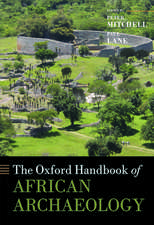Greater Ethiopia: The Evolution of a Multiethnic Society
Autor Donald N. Levineen Limba Engleză Paperback – mai 2000
Greater Ethiopia combines history, anthropology, and sociology to answer two major questions. Why did Ethiopia remain independent under the onslaught of European expansionism while other African political entities were colonized? And why must Ethiopia be considered a single cultural region despite its political, religious, and linguistic diversity?
Donald Levine's interdisciplinary study makes a substantial contribution both to Ethiopian interpretive history and to sociological analysis. In his new preface, Levine examines Ethiopia since the overthrow of the monarchy in the 1970s.
"Ethiopian scholarship is in Professor Levine's debt. . . . He has performed an important task with panache, urbanity, and learning."—Edward Ullendorff, Times Literary Supplement
"Upon rereading this book, it strikes the reader how broad in scope, how innovative in approach, and how stimulating in arguments this book was when it came out. . . . In the past twenty years it has inspired anthropological and historical research, stimulated theoretical debate about Ethiopia's cultural and historical development, and given the impetus to modern political thinking about the complexities and challenges of Ethiopia as a country. The text thus easily remains an absolute must for any Ethiopianist scholar to read and digest."-J. Abbink, Journal of Modern African Studies
Donald Levine's interdisciplinary study makes a substantial contribution both to Ethiopian interpretive history and to sociological analysis. In his new preface, Levine examines Ethiopia since the overthrow of the monarchy in the 1970s.
"Ethiopian scholarship is in Professor Levine's debt. . . . He has performed an important task with panache, urbanity, and learning."—Edward Ullendorff, Times Literary Supplement
"Upon rereading this book, it strikes the reader how broad in scope, how innovative in approach, and how stimulating in arguments this book was when it came out. . . . In the past twenty years it has inspired anthropological and historical research, stimulated theoretical debate about Ethiopia's cultural and historical development, and given the impetus to modern political thinking about the complexities and challenges of Ethiopia as a country. The text thus easily remains an absolute must for any Ethiopianist scholar to read and digest."-J. Abbink, Journal of Modern African Studies
Preț: 249.88 lei
Nou
Puncte Express: 375
Preț estimativ în valută:
47.82€ • 49.74$ • 39.48£
47.82€ • 49.74$ • 39.48£
Carte tipărită la comandă
Livrare economică 12-26 aprilie
Preluare comenzi: 021 569.72.76
Specificații
ISBN-13: 9780226475615
ISBN-10: 0226475611
Pagini: 256
Dimensiuni: 152 x 229 x 28 mm
Greutate: 0.27 kg
Ediția:Second Edition
Editura: University of Chicago Press
Colecția University of Chicago Press
ISBN-10: 0226475611
Pagini: 256
Dimensiuni: 152 x 229 x 28 mm
Greutate: 0.27 kg
Ediția:Second Edition
Editura: University of Chicago Press
Colecția University of Chicago Press
Cuprins
List of Tables
Preface 2000
Preface
1. Conventional Images of Ethiopia
A Far-Off Place
Ethiopia the Pious
A Magnificent Kingdom
Savage Abyssinia
A Bastion of African Independence
2. Scholarly Images and Assumptions
An Outpost of Semitic Civilization
An Ethnic Museum
An Underdeveloped Country
A Complex Evolving System
3. The Differentiation of Peoples and Cultures
Lines of Internal Differentiation
Lines of External Influence
The Peoples of Ethiopia: A Classification
4. Foundations of Unity
Greater Ethipia as a Relational Network
Greater Ethiopia as a Culture Area
The Ethiopian Response to Alien Influence
5. Patters of Expansion and Unification
Centers of Expansion before 1300
The Amhara Thesis
The Oromo Antithesis
The Ethiopian Synthesis
6. Four Questions
7. Tigrean Legacy: A National Script
The Kibre Negest: A Reassessment
Prologue, Narrative, and Epilogue
The Kibre Negest as a National Epic
A Cultural Identity Struggle
The Tigrean Contribution
8. The Amhara System
Household, Seignory, and Parish
The Nation as a Community
Functional Specialization
Hierarchical Interaction
Individualistic Association
System Stability and Historical Change
9. The Oromo System
Oila, Lineage, and Class
The Agnatic Community
Functional Redundancy
Egalitarian Interaction
Solidaristic Association
System Instability and Historical Change
10. Comparisons and Explanations
The Question of Amhara Expansions
The Questions of the Oromo Victories
The Question of Amhara-Tigrean Resurgence
The Question of Oromo Affiliation
11. Social Evolution in Ethiopia
Holistic Specialization
Mutalistic Specialization
Internal Specialization: The Formation of Ruling Elites
Despecialization and New Evolutionary Potential
Internal Specialization: The Creation of Free-floating Resources
The Present Evolutionary Situation
The Evolution of Ethiopian Society
Appendix: Roster of the Peoples of Ethiopia
Notes
Bibliography
Addendum to the Bibliography
Index
Preface 2000
Preface
1. Conventional Images of Ethiopia
A Far-Off Place
Ethiopia the Pious
A Magnificent Kingdom
Savage Abyssinia
A Bastion of African Independence
2. Scholarly Images and Assumptions
An Outpost of Semitic Civilization
An Ethnic Museum
An Underdeveloped Country
A Complex Evolving System
3. The Differentiation of Peoples and Cultures
Lines of Internal Differentiation
Lines of External Influence
The Peoples of Ethiopia: A Classification
4. Foundations of Unity
Greater Ethipia as a Relational Network
Greater Ethiopia as a Culture Area
The Ethiopian Response to Alien Influence
5. Patters of Expansion and Unification
Centers of Expansion before 1300
The Amhara Thesis
The Oromo Antithesis
The Ethiopian Synthesis
6. Four Questions
7. Tigrean Legacy: A National Script
The Kibre Negest: A Reassessment
Prologue, Narrative, and Epilogue
The Kibre Negest as a National Epic
A Cultural Identity Struggle
The Tigrean Contribution
8. The Amhara System
Household, Seignory, and Parish
The Nation as a Community
Functional Specialization
Hierarchical Interaction
Individualistic Association
System Stability and Historical Change
9. The Oromo System
Oila, Lineage, and Class
The Agnatic Community
Functional Redundancy
Egalitarian Interaction
Solidaristic Association
System Instability and Historical Change
10. Comparisons and Explanations
The Question of Amhara Expansions
The Questions of the Oromo Victories
The Question of Amhara-Tigrean Resurgence
The Question of Oromo Affiliation
11. Social Evolution in Ethiopia
Holistic Specialization
Mutalistic Specialization
Internal Specialization: The Formation of Ruling Elites
Despecialization and New Evolutionary Potential
Internal Specialization: The Creation of Free-floating Resources
The Present Evolutionary Situation
The Evolution of Ethiopian Society
Appendix: Roster of the Peoples of Ethiopia
Notes
Bibliography
Addendum to the Bibliography
Index












